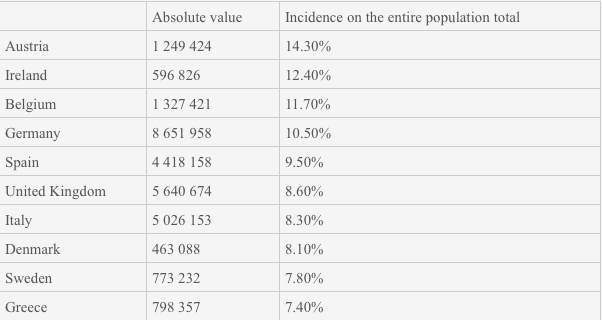Europe, the false myth of invasion of migrants. Eurostat and Istat data point to the need for migration flows: with closed borders Italy would risk the demographic decline.
The false myth of invasion
“There is an invasion” has become one of the mantras of the current populist demagogy related to the issue of migratory flows. Media bombing is nothing more than being its megaphone.
It is to wonder if it is only a perception or whether it is actually backed up by certain data, in order not to repeat the mistake made in 2014. Indeed, that year was published the “Index of Ignorance” survey, by the British agency Ipsos Mori. The study was aimed at verifying the false perception on various sociological issues, including immigration. Italy was awarded the first position, claiming that 30% of its population were immigrants, when in fact it was only 8%.
So let’s talk the numbers again, remembering that each number is not just and simply a number, but a person.
According to the update provided by the ISMU (Migration Research Initiatives and Studies on Multiethnicity) 75,000 migrants landed in Europe, including 63,000 in Italy in 2016. Among them, 8,300 are unaccompanied minors.
Greece and Spain, on the other hand, see a reduction on arrivals. After the EU-Turkey agreement, the flow remains contained in Greece: 7.731; while in Spain arrivals are 3,200.
These numbers, however, are an unstable component, as they do not provide a clear idea of the presence of foreigners in the European scenario.

Thus, the main issue we will consider is that of a resident foreign population living in Europe, identifying, therefore, those who reside in a country but have the citizenship of another.
The situation updated according to the data provided last year is as follows:

Fonte: Le Nius
It is evident that this is not an invasion phenomenon. What is to be said how is it possible that such a delicate migratory phenomenon that involves women, men and children who are exhausted by degrading and tragic situations in their own countries of origin and, subsequently, by that disturbing odyssey that characterizes their Crosses, you may have such misleading perceptions? Did we really miss our humanity?
As noted by Director of Search for “Index of Ignorance,” Bobby Duffy, “These perceptions represent a crucial issue in the public debate because they direct political strategies. If we could have a clearer vision and adhering to the reality of the size of the immigration phenomenon, public priorities would have a very different agenda. ”
How would Europe be without migrants?
“How would Europe appear if it could be able to effectively close the borders?” Is the question that researchers from the Leone Moressa Foundation have come up with, consulting Eurostat and Istat estimates.
The result? It is an apocalyptic scenario: “An old continent, poorer and less productive”. The potential for a migration balance of zero would imply the loss of 30 million people of working age in an imaginary 2030.
In this hypothetical future, characterized by closed borders and current birth rates, Europe would see its population decline of 1.9%, or, anyhow, below 500 million.
Indeed, the evolution of the population is the result of a number of factors, which can be divided into two main elements: the natural one and the migratory one. The natural factor is outlined by the dynamics of birth/mortality and fertility, the migratory one sees its determination by the presence of incoming and outgoing residents flows in a given territory.
Thus, at closed borders, Europe would incur a decline in the population, the consequence of which, considering the hope of an average age increase and an aging tendency, would result in a reduction in the working age range. Young people would lower almost to 8 million, pouring out the adverse consequences on the labor market.
How would Italy be without migrants?
The Italian hypothetical future scenario “without migrants” would not obviously be disconnected from the fate of Europe. The country is, in fact, at the brink of a demographic decline: 2.6 million young people less.
In fact, immigrants are on average younger than the Italians and more likely, according to estimates, to have children. The aforementioned figure would have repercussions in the field of education, or in school. There would be 35,000 less classes in public institutions, with the implication of the loss of 68,000 teachers (9.5% of the total).
Repercussions would also involve the labor market: in fact, we should give up 693,000 domestic workers (77% of the total).

Future Developments: Italy in 2030
Summing up what has been said so far, in the absence of migratory flows, the European population, and particularly the Italian population, would be destined for an inevitable demographic decline.
The aging process of the population combined with the decline in numbers would be a problematic factor for keeping the current social status.
However, it is not our case. Demographic input from foreigners is exerting a brake on this tendency. How will Italy, for example, be in 15 years time, with current migratory flows?
By 2030, immigrants will be 14.6% of the population. The labor market will change as foreign workers will be 4 million, so 18% of the employed. Thus, the GDP produced by immigrants will amount to about 217 billion, 15% of the total, recalling that today it is little below 9%.
So it is true that there are landings, difficulties in managing arrivals, but migration flows are a clear benefit. In fact, alongside the difficulties highlighted are the companies that are born, the families receiving the help of foreign carers, and so on.
Immigrants are the benefit of today and tomorrow.
Translation by Lucia Loddo.







3 comments for “ Europe is (not) a country for migrants”